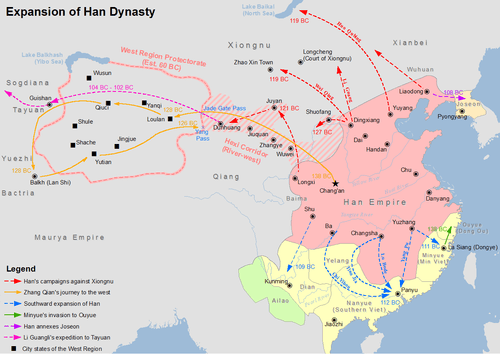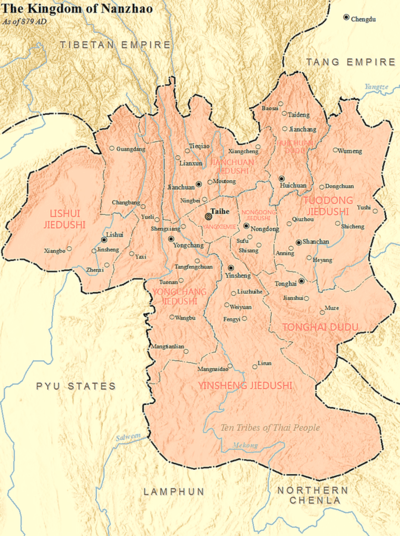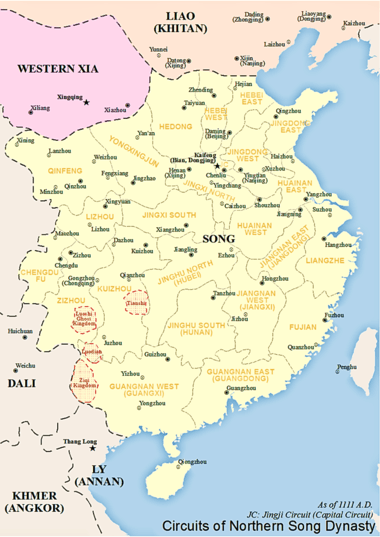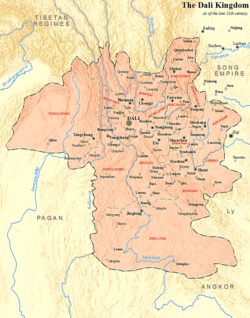Timeline of Yunnan-Guizhou
4th century BC
| Year | Date | Event |
|---|---|---|
| 328 | Chu military commander Zhuang Qiao invades Yunnan and sets up the Dian Kingdom[1] |
2nd century BC
| Year | Date | Event |
|---|---|---|
| 135 BC | Tang Meng creates Jianwei Commandery (modern Zunyi)[1] | |
| 122 BC | Emperor Wu of Han sends envoys to the southwest in search of a route to Daxia[2] | |
| 111 BC | Zangke Commandery is created in modern Guiyang and Yelang is vassalized[3] | |
| 109 BC | Han conquest of Dian: The Dian Kingdom and Tian Kingdom become Han vassals and Yizhou Commandery is created in modern Qujing[3] |
1st century BC
| Year | Date | Event |
|---|---|---|
| 86 BC | Rebellion occurs in the southwest[4] | |
| 83 BC | Rebellion occurs in the southwest[4] | |
| 27 BC | Aboriginals rebel in the southwest[5] |
1st century
| Year | Date | Event |
|---|---|---|
| 12 | Aboriginals in Zangke Commandery (Guizhou) rebel[5] | |
| 14 | Aboriginals in Yi Province rebel[5] | |
| 45 | Aboriginals rebel in the southwest[6] | |
| 51 | An Ailao tribe defects to Han[7] | |
| 57 | Yongchang Commandery is created in modern Kachin State[6] | |
| 69 | An Ailao tribe defects to Han[7] |
2nd century
| Year | Date | Event |
|---|---|---|
| 107 | Aboriginals rebel in the southwest[6] | |
| 116 | Aboriginals rebel in the southwest[6] | |
| 123 | Aboriginals rebel in the southwest[6] | |
| 146 | Policy of assimilation in the southwest is implemented through education programs[4] | |
| 156 | Aboriginals rebel in the southwest[6] | |
| 159 | Aboriginals rebel in the southwest[6] | |
| 176 | Aboriginals rebel in the southwest[6] |
3rd century
| Year | Date | Event |
|---|---|---|
| 225 | Zhuge Liang's Southern Campaign: Zhuge Liang conquers Nanzhong[8] |
6th century
| Year | Date | Event |
|---|---|---|
| 570 | Cuan Zan splits his realm into the Wuman/Black Mywa, ruled by his son Cuan Zhen, in the east and the Baiman/White Mywa, ruled by his eldest son Cuan Wan, in the west[10] | |
| 593 | The Cuanman rebel in Yunnan[9] | |
| 597 | A campaign is launched against the Cuanman[9] |
8th century
| Year | Date | Event |
|---|---|---|
| 703 | Tridu Songtsen of the Tibetan Empire subjugates the White and Black Mywa[11] | |
| 737 | Piluoge (皮羅閣) unites the six zhaos (kingdoms) of the White Mywa with Tang support[12] | |
| 751 | Xianyu Zhongtong attacks Nanzhao with an army of 80,000 but is utterly defeated, losing three quarters of his original force[13] | |
| 754 | Yang Guozhong invades Nanzhao but fails to engage with the enemy until supplies ran out, at which time they were attacked and routed[13] |
9th century
| Year | Date | Event |
|---|---|---|
| 801 | Tang and Nanzhao defeat Tibetan Empire and their Abbasid slave soldiers[14] | |
| 829 | Nanzhao takes Chengdu and captures 20,000 Chinese engineers[15] | |
| 846 | Nanzhao raids Annam[16] | |
| 861 | Nanzhao attacks Bo Prefecture and Annam but is repulsed.[17] | |
| 863 | Nanzhao conquers Annam[18] | |
| 866 | Gao Pian retakes Annam from Nanzhao[18] | |
| 869 | Nanzhao lays siege to Chengdu but fails to capture it[19] | |
| 870 | Nanzhao lays siege to Chengdu (in Sichuan)[18] | |
| 877 | Nanzhao retreats from Qianzhong Circuit in modern Guizhou[19] |
10th century
| Year | Date | Event |
|---|---|---|
| 902 | Zheng Maisi murders the king of Nanzhao and sets up his own Dachanghe regime[9] | |
| 928 | Zhao Shanzhen kills the king of Dachanghe and sets up Datianxing[9] | |
| 929 | Yang Hefeng removes Zhao Shanzhen and sets up Dayining[9] | |
| 937 | Duan Siping defeats Dayining and creates the Dali Kingdom[9] | |
| 967 | Long Yanyao of Nanning, the Yang clan of Bo Prefecture, and the Tian clan of Si Prefecture submit to the Song dynasty in return for their autonomy[20] | |
| Song dynasty recognizes the Bole of the Luodian kingdom, the Mangbu of the Badedian kingdom, and the Awangren of the Yushi kingdom[21] | ||
| 975 | Emperor Taizu of Song tries to convince Pugui of the Mu'ege Kingdom situated in northwest, central, east, and southeast Guizhou to acquiesce to Song overlordship[22] | |
| 976 | Song dynasty and aboriginal allies in Guizhou attack the Mu'ege Kingdom, forcing them to retreat to Dafang County[23] | |
| 980 | Long Yanyao's grandson Long Qiongju presents tribute to the Emperor Taizong of Song[20] | |
| 995 | Long Hanyao of Nanning presents tribute to the Song court[20] | |
| 998 | Long Hanyao of Nanning presents tribute to the Song court[20] |
11th century
| Year | Date | Event |
|---|---|---|
| 1042 | Song dynasty appoints Degai of the Mu'ege Kingdom as regional inspector[23] | |
| 1043 | The Yao people of Guiyang rebel[24] | |
| 1049 | Nong Zhigao of the Zhuang people rebels in Guangnan West Circuit[24] | |
| 1051 | The Yao rebellion of Guiyang is suppressed[24] | |
| 1053 | Nong Zhigao's rebellion is suppressed[24] |
12th century
| Year | Date | Event |
|---|---|---|
| 1133 | Ayong of the Mu'ege Kingdom leads a large trade delegation of several thousand to the Song city of Luzhou in Sichuan[21] |
13th century
| Year | Date | Event |
|---|---|---|
| 1208 | Yao people rebel in Jinghu and are suppressed[25] | |
| 1252 | summer | Möngke Khan places Kublai Khan in charge of the invasion of the Dali Kingdom[26] |
| 1253 | September | Kublai Khan's forces set up headquarters on the Jinsha River in western Yunnan and march on Dali in three columns[26] |
| 1254 | January | The Dali Kingdom is conquered, although its dynasty remains in power, and the king, Duan Xingzhi, is later invested with the title of Maharajah by Möngke Khan; so ends the Dali Kingdom[27] |
| winter | Kublai Khan returns to Mongolia and leaves Subutai's son Uryankhadai in charge of campaigns against local Yi tribes[27] | |
| 1257 | Uriyangkhadai, son of Subutai, pacifies Yunnan and returns to Gansu[27] | |
| winter | Mongol invasions of Vietnam: Uriyangkhadai returns to Yunnan and invades the Trần dynasty of Đại Việt[27] |
14th century
| Year | Date | Event |
|---|---|---|
| 1332 | March | War of the Two Capitals: Loyalist rebels in Yunnan are defeated[28] |
| 1360 | Basalawarmi takes control of Yunnan[29] | |
| 1381 | December | Ming conquest of Yunnan: Ming forces take Qujing[30] |
| 1382 | April | Ming conquest of Yunnan: Ming forces conquer Yunnan[31] |
| 1386 | January | Ming–Mong Mao War: Si Lunfa of Mong Mao rebels[32] |
| 1388 | Ming–Mong Mao War: Mong Mao is defeated by the Ming artillery corps utilizing volley fire[33] | |
| 1389 | January | Ming forces defeat Yi rebels in Yuezhou[34] |
| December | Ming–Mong Mao War: Si Lunfa surrenders to the Ming dynasty[34] | |
| 1397 | December | Ming–Mong Mao Intervention: Si Lunfa is deposed and requests Ming aid in restoring him to power[35] |
| 1398 | January | Ming–Mong Mao Intervention: Si Lunfa is restored to power[36] |
15th century
| Year | Date | Event |
|---|---|---|
| 1438 | 8 December | Luchuan–Pingmian campaigns: Ming carries out a punitive expedition against Si Renfa of Mong Mao for attacking neighboring tusi, but fails to defeat him[37] |
| 1441 | 27 February | Luchuan–Pingmian campaigns: Ming forces attack Mong Mao[38] |
| 1442 | January | Luchuan–Pingmian campaigns: Mong Mao is defeated but Si Renfa escapes to Ava[39] |
| 1443 | March | Luchuan–Pingmian campaigns: Ming forces defeat Si Jifa but fail to capture him[40] |
| 1445 | August | Luchuan–Pingmian campaigns: Ava hands over Si Renfa to Ming in return for their support in attacking Hsenwi[41] |
| 1446 | January | Luchuan–Pingmian campaigns: Si Renfa is executed[41] |
| 1449 | March | Luchuan–Pingmian campaigns: Ming forces invade Mong Yang for harboring Si Jifa, but he manages to escape again[42] |
| 1450 | Miao rebellions under the Ming dynasty: Yao and Miao people rebel in Guizhou and Huguang[43] | |
| 1452 | Miao rebellions under the Ming dynasty: Yao and Miao rebels are suppressed[43] | |
| 1456 | Miao rebellions under the Ming dynasty: Miao people in Huguang rebel and are suppressed[43] | |
| 1464 | Hou Dagou of the Yao people rebels in Guangxi[44] | |
| 1466 | January | Ming forces defeat and capture Hou Dagou, but the rebellion continues anyway[44] |
| Miao rebellions under the Ming dynasty: Miao people rebel in Hunan as well as the Sichuan-Guizhou border and are suppressed[45] | ||
| 1475 | Miao rebellions under the Ming dynasty: Miao people rebel in Hunan and are suppressed[45] | |
| 1479 | Miao rebellions under the Ming dynasty: Miao people rebel in Sichuan[46] | |
| 1499 | Yi people rebel in Guizhou[47] |
16th century
| Year | Date | Event |
|---|---|---|
| 1502 | Yi rebels in Guizhou are suppressed[47] | |
| 1589 | Bozhou rebellion: Miao people rebel in Bozhou[48] | |
| 1592 | 14 July | Ordos Campaign: Ye Mengxiong brings cannons and additional Miao troops to the siege of Ningxia[49] |
| 1594 | Bozhou rebellion: Ming forces are defeated in Sichuan[50] | |
| 1598 | Bozhou rebellion: The Miao rebellion is suppressed[50] |
17th century
| Year | Date | Event |
|---|---|---|
| 1606 | Army officers in Yunnan riot and kill Yang Rong, a eunuch superintendent of mining[51] | |
| 1621 | fall | She-An Rebellion: Yi people rebel in Sichuan and Guizhou[52] |
| 1623 | She-An Rebellion: Ming forces are defeated[52] | |
| 1624 | She-An Rebellion: Ming forces defeat rebels but are unable to decisively quell the rebellion[52] | |
| 1629 | She-An Rebellion: The rebels are defeated[52] | |
| 1656 | March | The Yongli Emperor arrives in Yunnan[53] |
| 1657 | October | Sun Kewang's forces are defeated by Li Dingguo in eastern Yunnan and he retreats to Guizhou[53] |
| 1659 | 7 January | Qing forces advance into Yunnan and the Yongli Emperor flees to Toungoo dynasty[54] |
| 10 March | Qing forces capture Yongchang and defeat Li Dingguo's army, securing Yunnan[54] |
Gallery
 Ancient southern China
Ancient southern China Han conquest of Dian, 109 BC
Han conquest of Dian, 109 BC Nanzhao, 879
Nanzhao, 879 Song dynasty, 1111
Song dynasty, 1111 Dali Kingdom, late 12th century
Dali Kingdom, late 12th century Yuan dynasty, 1330
Yuan dynasty, 1330
 Qing dynasty, 1820
Qing dynasty, 1820
gollark: Why not "every homosexual being"?
gollark: The orbital gender spy satellites would alert all your social contacts if you violate gender roles.
gollark: > Afaik the gender identity is impossible to detect by any person but themselvesIdea: orbital gender monitoring spy satellites.
gollark: Our electoral system *is* very awful.
gollark: Great!
References
- Twitchett 2008, p. 457.
- Watson 1993, p. 236.
- Twitchett 2008, p. 458.
- Twitchett 2008, p. 459.
- Twitchett 2008, p. 235.
- Twitchett 2008, p. 460.
- Twitchett 2008, p. 272.
- Xiong 2009, p. lxxxviii.
- Yang 2008a.
- https://medium.com/@diantnam/the-great-diantnam-248e2d4b6658
- Beckwith 1987, p. 64.
- Wang 2013, p. 103.
- Graff 2002, p. 214.
- Beckwith 1987, p. 157.
- Herman 2007, pp. 33, 35.
- Taylor 2013, p. 41.
- Herman 2007, p. 36.
- Xiong 2009, p. cxiv.
- Herman 2007, p. 37.
- Herman 2007, p. 39.
- Herman 2007, p. 43.
- Herman 2007, p. 40.
- Herman 2007, p. 42.
- Twitchett 2009, p. 329.
- Twitchett 2009, p. 831.
- Twitchett 1994, p. 405.
- Twitchett 1994, p. 407.
- Twitchett 1994, p. 545.
- Twitchett 1998, p. 72.
- Twitchett 1998, p. 144.
- Mote 2003, p. 557.
- Liew 1996, pp. 163–164.
- Andrade 2016, p. 158.
- Twitchett 1998, p. 160.
- Fernquest 2006, p. 47.
- Fernquest 2006, pp. 47–48.
- Liew 1996, pp. 174–175.
- Liew 1996, p. 178.
- Liew 1996, pp. 181–182.
- Liew 1996, p. 184.
- Liew 1996, p. 185.
- Liew 1996, p. 192.
- Twitchett 1998, p. 336.
- Twitchett 1998, p. 377.
- Twitchett 1998, p. 380.
- Twitchett 1998, p. 383.
- Twitchett 1998, p. 381.
- Lewis 2015, p. 209.
- Swope 2009, p. 30.
- Dardess 2012, p. 9.
- Twitchett 1998, p. 531.
- Dardess 2012, p. 10.
- Twitchett 1998, p. 706.
- Twitchett 1998, p. 707.
Bibliography
- Andrade, Tonio (2016), The Gunpowder Age: China, Military Innovation, and the Rise of the West in World History, Princeton University Press, ISBN 978-0-691-13597-7.
- Beckwith, Christopher I (1987), The Tibetan Empire in Central Asia: A History of the Struggle for Great Power among Tibetans, Turks, Arabs, and Chinese during the Early Middle Ages, Princeton University Press
- Crespigny, Rafe (2007), A Biographical Dictionary of Later Han to the Three Kingdoms (23-220 AD), Brill
- Dardess, John (2012), Ming China 1368-1644 A Concise History of A Resilient Empire, Roman & Littlefield Publishers, Inc.
- Fernquest, John (2006), Crucible of War: Burma and the Ming in the Tai Frontier Zone (1382-1454)
- Graff, David A. (2002), Medieval Chinese Warfare, 300-900, Warfare and History, London: Routledge, ISBN 0415239559
- Graff, David Andrew (2016), The Eurasian Way of War Military Practice in Seventh-Century China and Byzantium, Routledge, ISBN 978-0-415-46034-7.
- Herman, John E. (2007), Amid the Clouds and Mist China's Colonization of Guizhou, 1200–1700, Harvard University Asia Center, ISBN 978-0-674-02591-2
- Lewis, James (2015), The East Asian War, 1592-1598: International Relations, Violence and Memory, Routledge
- Liew, Foon Ming (1996), The Luchuan-Pingmian Campaigns (1436-1449) in the Light of Official Chinese Historiography
- Swope, Kenneth M. (2009), A Dragon's Head and a Serpent's Tail: Ming China and the First Great East Asian War, 1592-1598, University of Oklahoma Press.
- Swope, Kenneth (2014), The Military Collapse of China's Ming Dynasty, Routledge
- Taylor, K.W. (2013), A History of the Vietnamese, Cambridge University Press
- Twitchett, Denis (1994), The Cambridge History of China, Volume 6, Alien Regime and Border States, 907-1368, Cambridge: Cambridge University Press, ISBN 0521243319
- Twitchett, Denis (1998), The Cambridge History of China Volume 7 The Ming Dynasty, 1368—1644, Part I, Cambridge University Press
- Twitchett, Denis (1998b), The Cambridge History of China Volume 8 The Ming Dynasty, 1368—1644, Part 2, Cambridge University Press
- Twitchett, Denis (2008), The Cambridge History of China 1, Cambridge University Press
- Twitchett, Denis (2009), The Cambridge History of China Volume 5 The Sung dynasty and its Predecessors, 907-1279, Cambridge University Press
- Wang, Zhenping (2013), Tang China in Multi-Polar Asia: A History of Diplomacy and War, University of Hawaii Press
- Watson, Burton (1993), Records of the Grand Historian by Sima Qian: Han Dynasty II (Revised Edition, Columbia University Press
- Xiong, Victor Cunrui (2009), Historical Dictionary of Medieval China, United States of America: Scarecrow Press, Inc., ISBN 0810860538
- Yang, Bin (2008a), "Chapter 3: Military Campaigns against Yunnan: A Cross-Regional Analysis", Between Winds and Clouds: The Making of Yunnan (Second Century BCE to Twentieth Century CE), Columbia University Press
- Yang, Bin (2008b), "Chapter 4: Rule Based on Native Customs", Between Winds and Clouds: The Making of Yunnan (Second Century BCE to Twentieth Century CE), Columbia University Press
- Yang, Bin (2008c), "Chapter 5: Sinicization and Indigenization: The Emergence of the Yunnanese", Between Winds and Clouds: The Making of Yunnan (Second Century BCE to Twentieth Century CE), Columbia University Press
This article is issued from Wikipedia. The text is licensed under Creative Commons - Attribution - Sharealike. Additional terms may apply for the media files.
